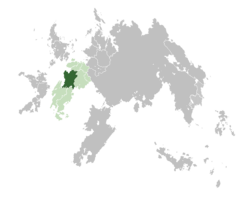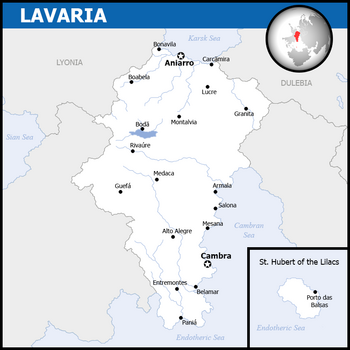Lavaria
Kingdom of Lavaria Reino da Lavária (Lavish) | |
|---|---|
| Motto: "Terra adorada, pátria amada." "Beloved land, loved nation" | |
| Anthem: Hymn of the Gentle Mother "Hino da Mãe Gentil" | |
 Location of Lavaria (dark green) in Cardia (green) | |
 | |
| Capital | Aniarro (seat of government) Cambra (constitutional) |
| Largest city | Aniarro |
| Official languages | Lavish |
| Ethnic groups |
Minority status:
|
| Demonym(s) | Lavish |
| Government | Unitary parliamentary constitutional monarchy |
• Monarch | Alberto Salazar I |
| Adriano Mafra de Chagas | |
| Legislature | National Parliament |
| Senado Nacional | |
| Câmara Popular | |
| Area | |
• Total | 556.507 km2 (214.869 sq mi) |
| Population | |
• Estimate | 45.538.936 |
• Density | 81.8/km2 (211.9/sq mi) |
| GDP (nominal) | 2017 estimate |
• Total | $1,1 trillion |
• Per capita | $24,867 |
| HDI (2016) | very high |
| Currency | Lirio (Lʟ$) |
| Date format | dd/mm/yyyy |
| Driving side | left |
| Calling code | +21 |
| Internet TLD | .la |
Lavaria (Lavish: Lavária [laˈvaɾia]), officially the Kingdom of Lavaria (Lavish: Reino da Lavária), is a sovereign state and constitutional monarchy located in central Cardia. Lavaria borders Arlyon to the south and Vetonia to the north. With an area of 556.507 km2, Lavaria is the second largest country in Cardia, behind Arlyon. By population (about 45 million), Lavaria is the second largest in Cardia and the fourth in Gaia. The capital is Cambra, while the seat of government and financial center is located in Aniarro. Other important urban areas of the country includes Boisbelle, Dornorra, Aire City, Mezana and Guefa.
Lavaria was a conglomerate of small independent kingdoms throughout the middle ages. The Lardian migration from Bralonia through the plain of Arenop over to northern Lavaria saw the increase of Ditanery practices among the Old Lavish kingdoms. With the rise of the Ditanery rule over the kingdoms, Lavaria witnessed a mass movement of unification. In 1553, the kingdoms of Cornícia and Abelana unified in a personal union in order to fight back the Dysian presence in the territory. The XXXX war lasted for over 50 years and ended with the conquest of Baileaniar (modern day Aniarro) in 1603. Mário I was crowned the King of Cornícia and Abelana. After being endorsed by the Piloro, Mário I started an expansionist movement to spread the Ditanery practices under the Cathartic Empire of Cornicae. Cornicae was victorious in the Continental War, allied with Mascylla and Krumlau. Through the marriage of Princess Sophia to King Maximilian I both monarchies were tied together and since then maintained a political relationship. The Empire was dissolved in 1943 leading to the creation of a parliamentary republic. A plebiscit was held in 1945, where the people voted for the return of the monarchy. Alberto I, from the house of Baltasar was crowned the first King of Lavaria. Since 1945, Lavaria has been a democratic parliamentary monarchy.

